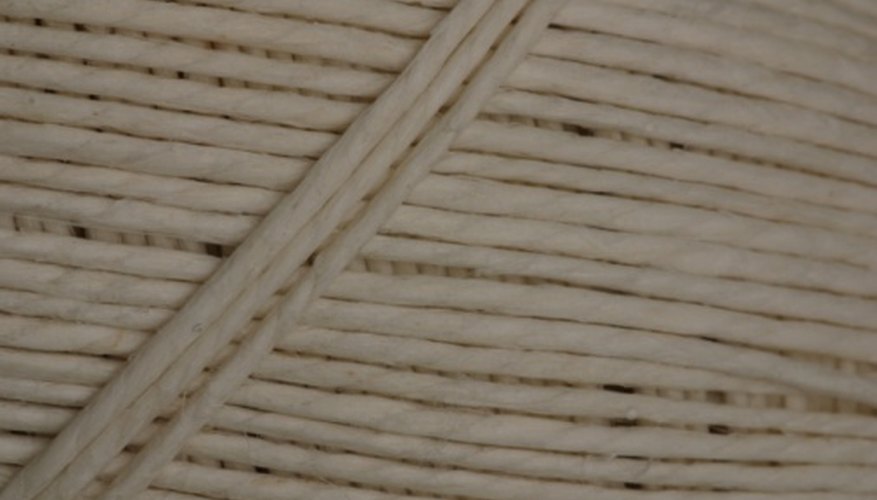Cotton comes in a variety of formats, including the woven cord known as cotton rope. Cotton rope is used in the manufacturing of pet toys, children's toys, backyard recreational products, or, in its simple form, to tie knots for camping activities, crafts, and clothing. With all its uses, cotton is a material that comes with a set of pros and cons.
Advantages & Disadvantages in Knotting
In his book "Complete Great Outdoors Encyclopedia" outdoor enthusiast Vin T. Sparano says that, in comparison, synthetic rope is more durable than cotton. Cotton and other ropes made of natural fibres can swell and kink in humidity, making them prone to mildew and damage over time. While cotton rope is more susceptible to fibre breakage, it does better than synthetic material in intense heat. A knot made from synthetic rope can slip and stretch in a warm environment, while a knot made from cotton is not affected by heat and is easier to grip in moist conditions.
- In his book "Complete Great Outdoors Encyclopedia" outdoor enthusiast Vin T. Sparano says that, in comparison, synthetic rope is more durable than cotton.
- A knot made from synthetic rope can slip and stretch in a warm environment, while a knot made from cotton is not affected by heat and is easier to grip in moist conditions.
Advantages & Disadvantages for Animal Safety
For the same reason rodents like to nibble on the natural fibres of cotton, birds love to preen their beaks in ropes made from cotton. However, birds can catch their toes in loosened strands of cotton fibre and become tangled, causing injury to themselves in the panic that follows. Bird owners should purchase bird-safe cotton rope that shreds into puffs when pulled.
Horse owners and trainers have found that while cotton rope halters are inexpensive and disposable, they will shrink when exposed to wet conditions. This makes the halters tight and can cause your horse irritation. Mildew is always a risk with cotton, which can also be a safety concern for animals if the cotton product is not cleaned regularly.
- For the same reason rodents like to nibble on the natural fibres of cotton, birds love to preen their beaks in ropes made from cotton.
- Mildew is always a risk with cotton, which can also be a safety concern for animals if the cotton product is not cleaned regularly.
Advantages in the Backyard
Skipping ropes, swings, and hammocks are just a few of the items you may find in your backyard that are made with cotton rope. Cotton rope is a natural, safe fibre that is disposable and earth friendly. Children's swings hung with rope instead of chains decreases the risk for injury if a child gets hit by the equipment.
Cotton skipping ropes offer the least sting to your child's skin when she misses a step, but she will also have to work harder to move the lightweight cotton rope against air resistance, forcing her to jump faster, as opposed to the weighted, easy handling of skipping ropes made from nylon or beads.
- Skipping ropes, swings, and hammocks are just a few of the items you may find in your backyard that are made with cotton rope.
- Cotton skipping ropes offer the least sting to your child's skin when she misses a step, but she will also have to work harder to move the lightweight cotton rope against air resistance, forcing her to jump faster, as opposed to the weighted, easy handling of skipping ropes made from nylon or beads.
Cotton rope hammocks, especially organic, pesticide-free cotton, are also popular summer backyard items because the ventilated fibres are cool and comfortable against hot skin, and the lightweight, portable material makes them easy to take on camping trips and vacations.
The Cotton Shortage
Although cotton is still one of the most widely used, affordable materials in the world, the effects of drought, restricted exports, and floods in three of the world's major cotton producers in 2010 caused cotton demand and prices to increase, bringing a shortage in some markets. This forced manufacturers to pass the price increase for cotton onto consumers. CNN Money reports that the inflated cost of cotton is something to watch in 2011, after the rising price of raw material has had its full effect on the cost of retail business. On the upside, the demand for cotton has given U.S. farmers an opportunity to fill the need by planting cotton on U.S. soil. As of February 2011, the National Cotton Council of America reported that despite the competition from other cotton markets, U.S. cotton export sales were rising at a record pace.
- Although cotton is still one of the most widely used, affordable materials in the world, the effects of drought, restricted exports, and floods in three of the world's major cotton producers in 2010 caused cotton demand and prices to increase, bringing a shortage in some markets.
- CNN Money reports that the inflated cost of cotton is something to watch in 2011, after the rising price of raw material has had its full effect on the cost of retail business.
